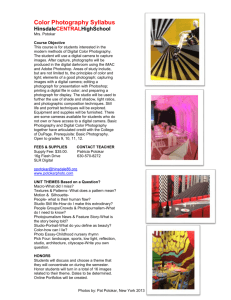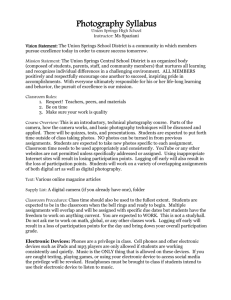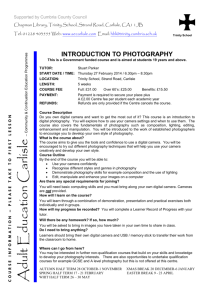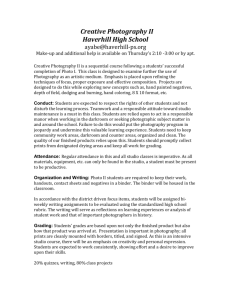Artist Statements
advertisement
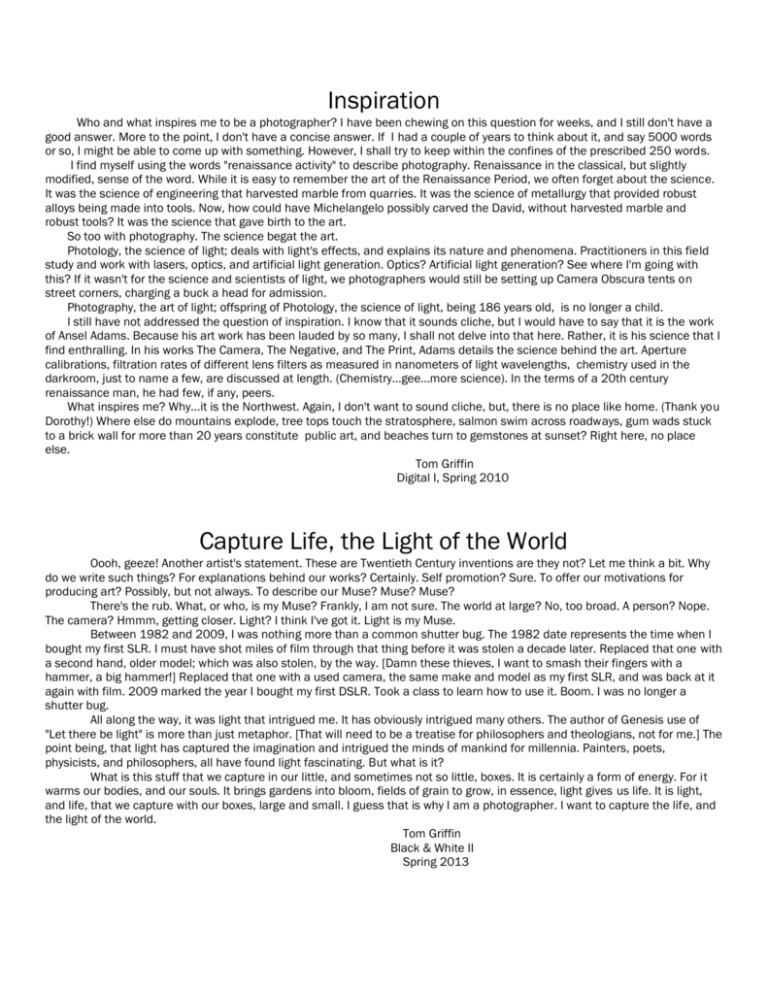
Inspiration Who and what inspires me to be a photographer? I have been chewing on this question for weeks, and I still don't have a good answer. More to the point, I don't have a concise answer. If I had a couple of years to think about it, and say 5000 words or so, I might be able to come up with something. However, I shall try to keep within the confines of the prescribed 250 words. I find myself using the words "renaissance activity" to describe photography. Renaissance in the classical, but slightly modified, sense of the word. While it is easy to remember the art of the Renaissance Period, we often forget about the science. It was the science of engineering that harvested marble from quarries. It was the science of metallurgy that provided robust alloys being made into tools. Now, how could have Michelangelo possibly carved the David, without harvested marble and robust tools? It was the science that gave birth to the art. So too with photography. The science begat the art. Photology, the science of light; deals with light's effects, and explains its nature and phenomena. Practitioners in this field study and work with lasers, optics, and artificial light generation. Optics? Artificial light generation? See where I'm going with this? If it wasn't for the science and scientists of light, we photographers would still be setting up Camera Obscura tents on street corners, charging a buck a head for admission. Photography, the art of light; offspring of Photology, the science of light, being 186 years old, is no longer a child. I still have not addressed the question of inspiration. I know that it sounds cliche, but I would have to say that it is the work of Ansel Adams. Because his art work has been lauded by so many, I shall not delve into that here. Rather, it is his science that I find enthralling. In his works The Camera, The Negative, and The Print, Adams details the science behind the art. Aperture calibrations, filtration rates of different lens filters as measured in nanometers of light wavelengths, chemistry used in the darkroom, just to name a few, are discussed at length. (Chemistry...gee...more science). In the terms of a 20th century renaissance man, he had few, if any, peers. What inspires me? Why...it is the Northwest. Again, I don't want to sound cliche, but, there is no place like home. (Thank you Dorothy!) Where else do mountains explode, tree tops touch the stratosphere, salmon swim across roadways, gum wads stuck to a brick wall for more than 20 years constitute public art, and beaches turn to gemstones at sunset? Right here, no place else. Tom Griffin Digital I, Spring 2010 Capture Life, the Light of the World Oooh, geeze! Another artist's statement. These are Twentieth Century inventions are they not? Let me think a bit. Why do we write such things? For explanations behind our works? Certainly. Self promotion? Sure. To offer our motivations for producing art? Possibly, but not always. To describe our Muse? Muse? Muse? There's the rub. What, or who, is my Muse? Frankly, I am not sure. The world at large? No, too broad. A person? Nope. The camera? Hmmm, getting closer. Light? I think I've got it. Light is my Muse. Between 1982 and 2009, I was nothing more than a common shutter bug. The 1982 date represents the time when I bought my first SLR. I must have shot miles of film through that thing before it was stolen a decade later. Replaced that one with a second hand, older model; which was also stolen, by the way. [Damn these thieves, I want to smash their fingers with a hammer, a big hammer!] Replaced that one with a used camera, the same make and model as my first SLR, and was back at it again with film. 2009 marked the year I bought my first DSLR. Took a class to learn how to use it. Boom. I was no longer a shutter bug. All along the way, it was light that intrigued me. It has obviously intrigued many others. The author of Genesis use of "Let there be light" is more than just metaphor. [That will need to be a treatise for philosophers and theologians, not for me.] The point being, that light has captured the imagination and intrigued the minds of mankind for millennia. Painters, poets, physicists, and philosophers, all have found light fascinating. But what is it? What is this stuff that we capture in our little, and sometimes not so little, boxes. It is certainly a form of energy. For it warms our bodies, and our souls. It brings gardens into bloom, fields of grain to grow, in essence, light gives us life. It is light, and life, that we capture with our boxes, large and small. I guess that is why I am a photographer. I want to capture the life, and the light of the world. Tom Griffin Black & White II Spring 2013 Richmond Beach After moving to the Northwest in the summer of 1997, I started to explore the different beaches of Puget Sound. I find myself attracted to beaches for some reason. Beaches are places for young and old alike. They can be a place of contrasts. Solace and contemplation, or play and recreation, beaches are a place where we humans can just be ourselves. I found myself attracted to Richmond Beach because it is very reminiscent of the beach where I spent my summers on the south shore of Lake Erie. A bit rough, with course sand and rocks for a shoreline. Driftwood is scattered about, occasionally arranged into crude structures. Seagulls and crows are omnipresent, scavenging for food. Richmond Beach can be well populated at times, with people enjoying a warm sunny day. There are other occasions where I am one of a few people there. In photographing the beach at different times and days, I believe I captured the varying elements of the place. The driftwood, both scattered about and arranged shows the impact of mother nature and mankind on this locale. Capturing images of wildlife proved difficult, as birds are leery of the camera. Getting photos of sea stars at low tide was much more successful. Tom Griffin Black and White II Spring 2013 Science Behind Photography As I struggle with writers block to produce his statement, I find myself stumbling over the lead question posed by the authors of our text. "Where do you get your ideas from?" I'll be damned if I know, ideas just arrive, sometimes unannounced. In reviewing the work for this past quarter, I found myself photographing performing musicians, wide landscapes, close ups of city park decor, including play areas for children. All are types of photography that I have a fondness for. I will always have an interest for the science behind the art of photography. For light, and the study of it, is a branch of physics all its own. Photology, the science of light and how it acts and reacts fascinates me. The way light behaves as it goes through a lens, especially when I have a constant aperture zoom lens on the camera, I find intriguing. In the past I have described photography as a renaissance activity. Science and art working together to produce a single field of study. For it was advances in science and technology that allowed photography as an art form to flourish. From cubic to tabular silver halide crystals for film production; from the first low megapixel CCD, to today's CMOS sensors, it is the science behind the art that inspires me to click the shutter. Tom Griffin Digital Photography II Winter 2013 On Walls On researching walls for this brief essay, I was unable to find a historical piece that could identify when human beings built the first wall. They are so commonplace, we hardly notice them, or, rather, we do not give then special attention. Yet, they hold significance in our lives. They provide us with protection from the elements, being the primary components of our homes. Walls have become monuments of nations; China's Great Wall and Hadrian's Wall separating England and Scotland come to mind. Walls have become destinations for those on pilgrimage; Jerusalem's Wailing Wall and the Viet Nam Memorial in Washington D.C., just to name two. I am sure that there are more. Walls as structural elements, can be made from a wide variety of materials. Be it wood, steel, brick, stone, or even glass; walls will always be around and surround us. With my "Walls" triptych, I am merely trying to convey the many functions of walls in our lives. Tom Griffin Digital Photography II Winter 2013 Why Black and White? For the digital photographer, producing an image in monochrome is a conscious choice. I do not plan to engage in the black and white versus color arguments here, which, frankly, have gone on too long. I am simply stating that a monochromatic photograph provides the essence of an image. Light, form, context, texture, all come through in black and white. Nostalgia for photography for the first half of the 20th century perhaps, but monochromia is a field I shall continue to work in. Tom Griffin Digital Photography II Winter 2013 WHAT AM I REALLY DOING? OK, good question. Taking photographs. All right, but how well? Decent enough, but getting better. But, what am I really doing? I am trying to bring some beauty to my life. The cluttered mess of my home notwithstanding, I need an artistic diversion to keep me sane. I work 36-44 hours a week as a nurse in a local emergency room on the night shift. I see much that would be gravely troubling to most human beings. I have seen methamphetamine abusers who are so psychotic that they do not know what town that they are in, let alone the day of the week. I have attempted to carry on a conversation with homeless individuals whose alcohol level is so high, their blood is likely to be considered flammable. I have cared for victims of gun violence, the youngest of which was just three weeks old. I have attempted to console parents of infants who have died of SIDS. I have, I do, and I shall provide care for those who cannot care for themselves; for those whose chronic illnesses have tipped out of balance; and for those whose illnesses or injuries come unexpectedly. Should the reader need some visual reinforcement of the activity in an E.R., I recommend Eugene Richards 1989 work, "The Knife And Gun Club". Nearly 25 years after its initial publication, it still receives praise from physicians, nurses and paramedics for its down to earth and honest portrayal of an E.R. I use photography as an escape from misery, not just those of others, but also my own. Dealing with the many issues in my workplace can become wearisome. With photography, I can get behind the lens and capture a moment, however brief, of beauty that I can enjoy. It helps be realize that there is more to our world that pain and injury. A colorful sunset, the reflection of a footbridge on water at night, the celestial spin of the stars around Polaris, a child flying a kite on a beach; all help ease my soul to keep be falling into an abyss of depression. For me, art is supposed to do that. However, there are those who make the point that art is to do more than just provide beauty. Art is to provoke thought, provide commentary, acts as a guide to others to live well, and when art works best, it provides inspiration for others to be creative. From my perspective, art that brings a smile or lifts a spirit, is fine art and the type of photography that I like to produce. Finding my way in the artistic community has not been easy. I do not know why, it just hasn't. For the most part, I am an introverted sort. I would rather spend my time curled up on the couch with a book instead of smoozing. I have donated works to local non-profit organizations for fund raiser auctions (LongShot not included) as a means of getting my photography out into the community to be seen. Granted, this is not a lot, but it is a start. The topic of what my art will be like after graduation is assigned to be part of this essay. Frankly, I have no idea. I am less than half way through the program at PCNW. One course at a time, as time and finances permit. However, I have recently come upon a media that I am very curious about. Photo-reactive glass. Please do not confuse this material with the glass that spectacles are made of. This medium is different. The glass has silver halides in the mix, making it reactive to ultraviolet light. There are some local glass artists that are familiar with this material, primarily from the art-glass perspective. I have aspirations of picking the brains of these artists to understand this material better so that I can use the glass as a photographic medium for printing. Tom Griffin Black & White II Spring 2013



